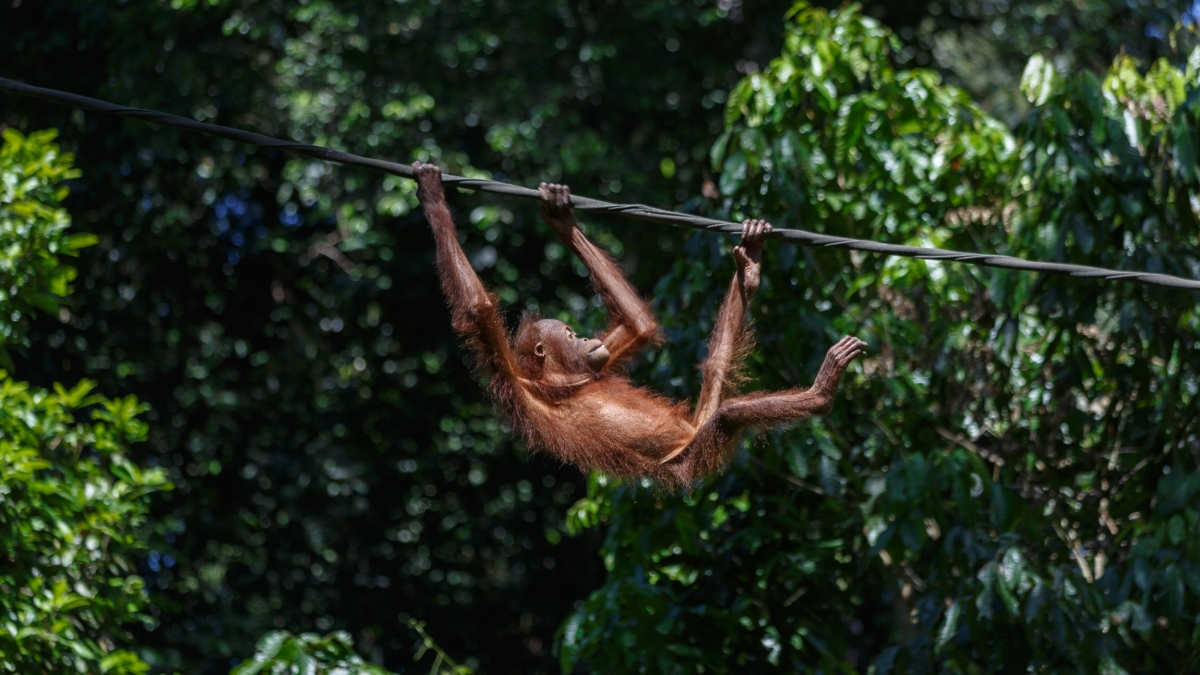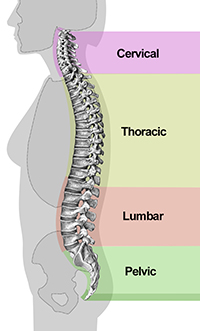New evidence for why there are changes in mammals' spinal columns

Orangutans are "suspensory" mammals.
Image credit: Wiki Commons Sandakan Sabah Sepilok Orangutan Rehabilitation Centre
A mammal’s posture while moving, or locomotor posture, plays a key role in how variable the number of vertebrae in its spinal column can be across all members of that species, a team of researchers, including Arizona State University graduate student Amy Peterson, has concluded in a new study appearing in the journal Nature Ecology and Evolution.
“While evolution has created change in many areas of an animal’s body,” said Peterson, an evolutionary anthropology student in the School of Human Evolution and Social Change, “there are some surprising consistencies among groups of animals, including how many vertebrae there are in the different segments of the spine."
Virtually all mammals have the same number of cervical (neck) vertebrae. Most also have between 19 and 20 combined thoracic (upper- and mid-back, with ribs attached) and lumbar (lower back) vertebrae. But, there are some species that show high variation between individuals in how many thoracic and lumbar vertebrae they have. For the species that show less variation, there must be a functional benefit to maintaining that stable number of vertebrae. Natural selection is working to keep that number stable because changing it is detrimental to the animal’s ability to move efficiently.
When a trait like number of vertebrae stays constant, despite many changes in how animals are moving, it means that there’s a reason that evolution cannot change that trait. For the cervical spine, it is thought that genetic mutations that affect the number of cervical vertebrae are also closely related to fetal abnormalities and defects. But this is not true of the thoracic or lumbar vertebrae, which means that their variation — or lack thereof — is controlled by how efficient it might be to produce variation in the spine.
Earlier research has suggested that the relationship between locomotion and stability in the number of vertebrae was primarily associated with running speed. Faster movement was thought to produce an evolutionary constraint on how many vertebrae could exist in the spine, while slower movement did not restrict variation in the same way.
This study, which included nearly 300 species of mammals from a wide variety of habitats, did not find evidence that slow-running species had more variation in number of vertebrae than closely-related, fast-running species.

The spinal column. Image credit: Wiki commons
To understand what factors might influence spinal variation, researchers conducted a series of analyses factoring in things like body posture; locomotor category; environment and habitat, such as arboreal or ground-dwelling; and locomotor speed. They found that suspensory mammals, like apes and sloths, exhibit the greatest degrees of variation in their thoracic and lumbar vertebral counts.
Suspensory behavior is a departure from the ancestral way of moving for mammals, which was to walk on all four limbs on the ground. Most terrestrial mammals have stayed walking on the ground, though some have adopted new behaviors, like the suspensory mammals.
Running is not the only factor in how mobile or stiff an animal’s spine needs to be. Some groups, like bovids (cows and their relatives) and elephants, have stiffer backs among their largest members, showing that body size plays a role in spinal function. In primates, those adapted to suspensory locomotion — hanging down below branches in trees — have also developed stiffer lower spines in order to reduce the risk of buckling during suspension, which could damage the intervertebral disks and other soft tissue.
Animals that have kept the ancestral body plan and way of moving, like dogs and horses, need to maintain the same number of vertebrae because their way of moving is most efficient with that number and altering that formula could cause them to be less efficient while walking and running. For animals that do not rely on the ancestral way of walking, such as suspensory groups, more variation can happen because it won’t affect their efficiency while moving around.
“It is clear that the changes in vertebral count across mammals have a complex evolutionary history,” Peterson said. “This new research highlights this complexity and is a step towards understanding how this trait has changed through time and across all mammal groups.”
More Science and technology

Famed systems engineer inspires ASU to tackle global problems
“Providing great talent with great opportunity can make a great difference.” Such was a key part of the message delivered by G.…

The science behind chronic stress
Stress comes in many shapes and sizes. There’s the everyday stress of preparing for a final exam or being stuck in traffic. And…

ASU planetary scientist to be inducted into the National Academy of Sciences
The National Academy of Sciences is inducting School of Earth and Space Exploration Director Meenakshi Wadhwa into the 2023 class…